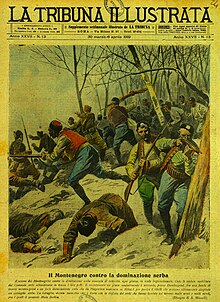| Christmas Uprising | |||||||
|---|---|---|---|---|---|---|---|
| Part of the aftermath of World War I and the creation of Yugoslavia | |||||||
 Cover of the Italian weekly La Tribuna Illustrata from 1919, titled "Montenegro against Serbian domination" (Italian: Il Montenegro contro la dominazione serba) | |||||||
| |||||||
| Belligerents | |||||||
|
Supported by: |
| ||||||
| Commanders and leaders | |||||||
|
|
| ||||||
| Strength | |||||||
| Estimates vary from 1,500[1] to 5,000[2] | Estimates vary from 500[3] to 4,000[4] | ||||||
| Casualties and losses | |||||||
| 98 killed and wounded | 30 killed[5] | ||||||
The Christmas Uprising (Serbian: Божићни устанак, romanized: Božićni ustanak), also known as the Christmas Rebellion (Божићна побуна, Božićna pobuna), was a failed uprising in Montenegro led by the Greens in early January 1919. The military leader of the uprising was Krsto Popović and its political leader was Jovan Plamenac.
The catalyst for the uprising was a decision of the controversial Great National Assembly of the Serb People in Montenegro, commonly known as the Podgorica Assembly. The assembly decided to directly unify the Kingdom of Montenegro with the Kingdom of Serbia, which would shortly after become the Kingdom of Yugoslavia. Following a questionable candidate selection process, the unionist Whites outnumbered the Greens, who were in favour of preserving Montenegrin statehood and unification in a confederal Dual Monarchy with Yugoslavia.
The uprising reached a climax in Cetinje on 7 January 1919, which was the date of Eastern Orthodox Christmas. The unionists with support from the Serbian Army defeated the rebel Greens. In the aftermath of the uprising, the dethroned King Nikola of Montenegro was forced to issue a call for peace, since many homes were destroyed. As a result of the uprising, a number of participants complicit in the uprising were tried and imprisoned. Other participants in the uprising fled to the Kingdom of Italy, meanwhile some retreated to the mountains and continued guerrilla resistance under the banner of the Montenegrin Army in exile, which lasted until 1929. The most notable guerilla militia leader was Savo Raspopović.
- ^ Pavlović, Srđa (2008). Balkan Anschluss: The Annexation of Montenegro and the Creation of the Common South Slavic State. Purdue University Press. p. 166. ISBN 9781557534651.
- ^ Novak Adžić (January 6, 2018). "Portal Analitika: Božićni ustanak crnogorskog naroda 1919. godine (I)" (in Serbian). Retrieved May 15, 2018.
- ^ Woodhouse & Woodhouse 1920, p. 111.
- ^ Andrijašević 2015, p. 262.
- ^ Novica Đurić (March 20, 2017). "Politika: Šetalište skriva grobnicu branilaca ujedinjenja sa Srbijom" (in Serbian).